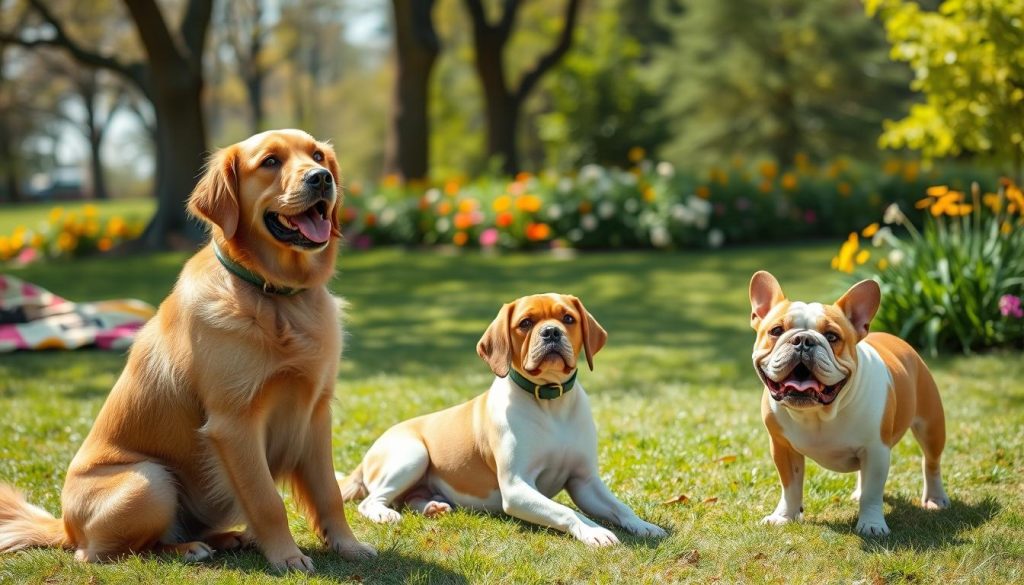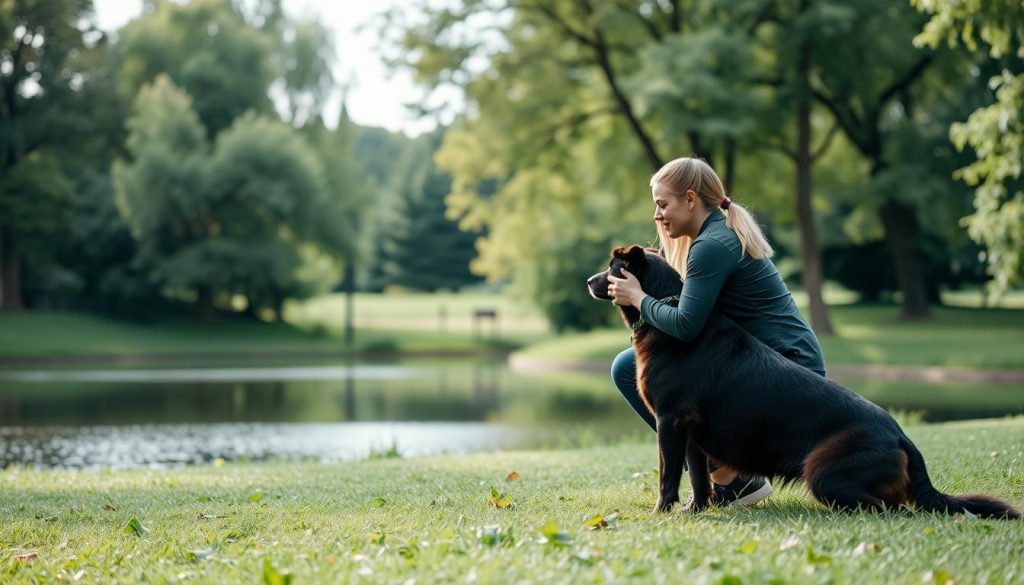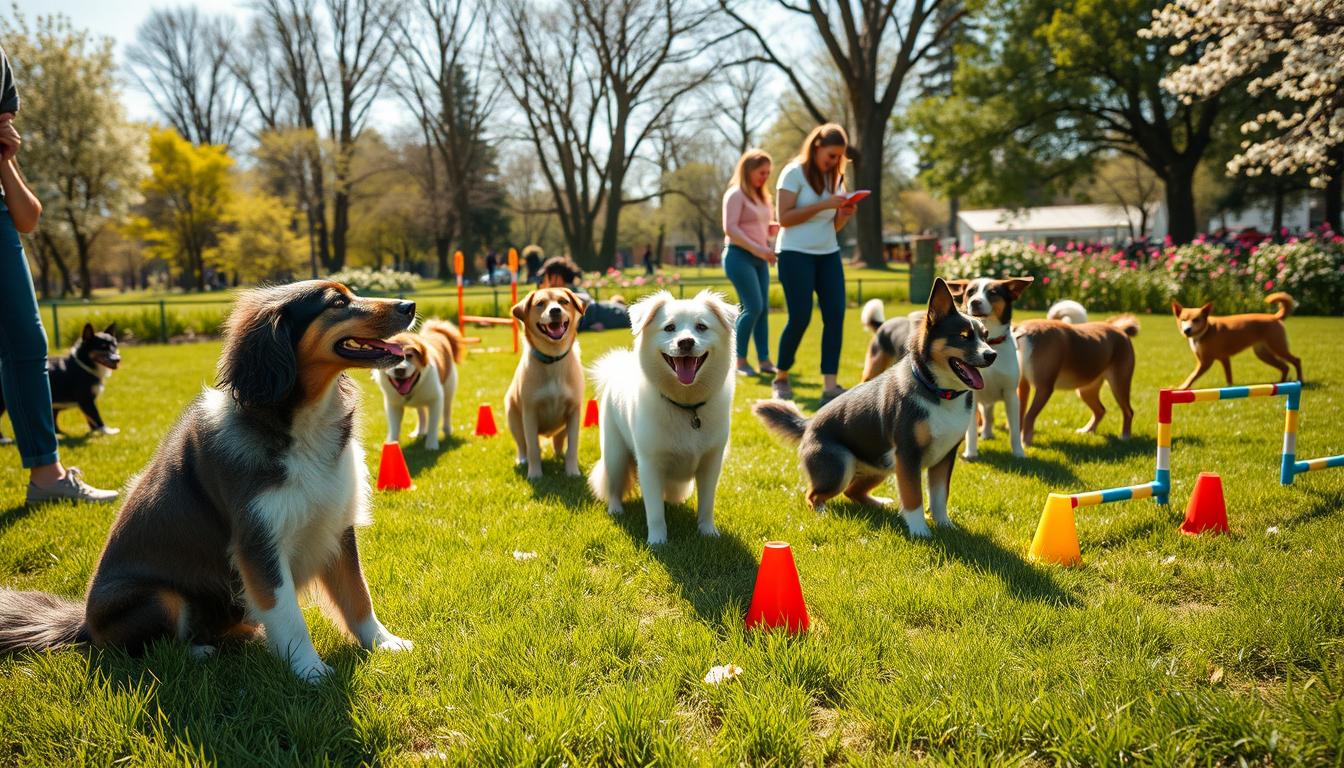Being a dog owner comes with both joy and challenges. Training your dog can seem tough, but with the right methods and patience, you can unlock their full potential. In this guide, I’ll share effective dog training methods to help you and your pup get along better.
The core of successful dog training is positive reinforcement. By rewarding good behavior, you build trust and cooperation with your dog. Positive reinforcement is key for teaching basic commands and solving complex behavioral issues.
I’ll also talk about the importance of patience and consistency in training. A calm and patient approach is crucial for your dog to learn and remember what you teach them.
Dog training isn’t just about obedience; it’s also about socialization. I’ll show you how introducing your pup to new experiences, people, and places can make them well-adjusted and sociable.
In this guide, you’ll find practical tips to overcome common dog training challenges. By the end, you’ll have the tools to make your pup happy and well-behaved, bringing joy to your life.
Positive Reinforcement: The Key to Successful Dog Training
https://www.youtube.com/watch?v=kqV4PQNJ8lI
As a passionate dog owner, I’ve learned the power of positive reinforcement training. It rewards good behaviors, making your dog more cooperative and enthusiastic. Understanding this approach helps you unlock your dog’s full potential and build a lifelong bond.
Understanding Positive Reinforcement
Positive reinforcement training links good behaviors with rewards like treats or praise. When your dog does something right, you give them something they like. This teaches them to repeat those actions because they enjoy the reward.
This method is kinder than old-school training that uses punishment. It makes your dog want to please you and builds trust. This leads to a more engaged and responsive learner. It’s great for changing bad habits and encouraging good ones.
Implementing Positive Reinforcement Techniques
Adding positive reinforcement to your dog’s training is easy and effective. Here are some tips to get started:
- Use high-value treats or favorite toys as rewards for desired behaviors.
- Incorporate the use of a clicker, which provides a clear, consistent signal that a behavior has been rewarded.
- Praise your dog enthusiastically when they exhibit good behavior, reinforcing the positive association.
- Be patient and consistent, as it may take time for your dog to fully understand and respond to the new training approach.
- Gradually increase the difficulty of the training tasks as your dog becomes more proficient.
By using positive reinforcement, you can change your dog’s behavior and build a strong bond. Remember, with patience, consistency, and rewards, you can unlock your pup’s true potential. This way, you’ll have a happy, well-trained companion for life.
Building a Strong Foundation with Basic Commands

Creating a solid foundation is crucial for successful dog training. Teaching your pup basic commands helps them become well-behaved and responsive. In this section, we’ll cover the essential commands – sit, stay, come, heel, and down.
The sit command is a great starting point. It teaches your dog to stay seated until you give them a cue to move. With patience and positive reinforcement, your pup will learn to sit on command. This skill is useful in many situations.
The stay command builds on the sit command. It tells your dog to stay in the same spot until you let them go. This skill is vital for obedience training and keeps your dog safe in dangerous situations.
The come command is very important. It teaches your dog to come back when called, preventing them from wandering off or getting into trouble. This command strengthens your bond with your dog.
The heel command helps your dog walk calmly by your side without pulling on the leash. This is crucial for controlling your dog during walks and preventing accidents.
Lastly, the down command teaches your dog to lie flat on the ground. This command is useful for calming your pup in stressful situations or when you need them to stay in one place.
By mastering these basic commands, you’ll lay a strong foundation for your dog’s obedience training. Remember, consistency and patience are key. With time and dedication, you’ll have a well-trained, responsive dog you can trust in any situation.
Mastering these fundamental commands will help your dog succeed and deepen your bond. Stick with it, and you’ll have a well-behaved, obedient pup in no time.
Dog Training: Mastering the Art of Patience and Consistency

Successful dog training needs patience and consistency. As a dog owner, these are key for teaching your pet new tricks and good habits. Let’s see why patience and consistency are so important in dog training.
The Importance of Patience in Dog Training
Patience is essential in dog training. Dogs learn at their own speed, and progress takes time. By staying calm and patient, you create a safe space for your dog to learn.
Rushing or getting angry can slow down learning and hurt your bond with your dog.
Staying Consistent: A Must for Effective Training
Consistency is crucial for effective dog training. Your dog needs to hear the same commands in the same way every time. If cues are mixed up, your dog gets confused.
By being consistent, your dog learns faster and builds a strong base for more training.
Patience and consistency are key for dog behavior modification and dog training challenges. With a positive, reinforcement-based approach, you can make your dog a well-trained, happy companion.
Socializing Your Pup: An Essential Aspect of Dog Training
Socializing your dog is key to their training and growth. As a pet owner, I’ve found that exposing your pup to different experiences and people is vital. It brings many benefits.
Benefits of Socialization for Dogs
Proper socialization can make dogs less anxious and more confident. It helps them interact better with people and other animals. This makes your dog more comfortable and well-adjusted in different situations.
Introducing your dog to new things in a positive way is important. It helps them learn social skills. This is good for your dog and makes the world a safer, happier place for them.

